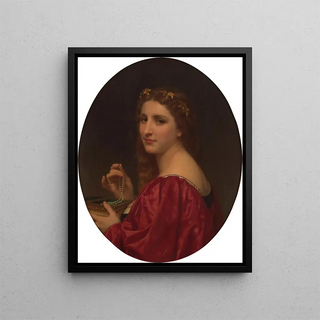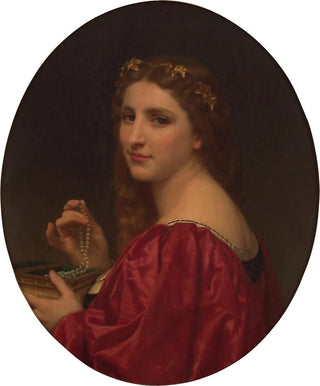Art print | Marguerite - William Bouguereau


View from behind

Frame (optional)
Marguerite Art print - William Bouguereau – Captivating Introduction
In the vast panorama of art history, certain works transcend time and continue to evoke deep emotions. "Marguerite" by William Bouguereau is one of these timeless creations. This painting, which captures the beauty and innocence of a young girl, transports us to a universe where purity and delicacy meet. The depiction of Marguerite, with her lively gaze and gentle expression, invites the viewer to reflect on the very essence of childhood, while celebrating the technical virtuosity of the artist. Bouguereau, master of realism, manages to breathe soul into his subjects, making each piece unique and memorable.
Style and uniqueness of the work
Bouguereau's style is distinguished by his meticulous attention to detail and his ability to reproduce light in an almost photographic manner. In "Marguerite," every element is carefully crafted, from the rendering of silky hair to the texture of the clothing. The artist uses soft, harmonious colors, creating a peaceful and dreamy atmosphere. The composition is balanced, with Marguerite placed at the center, immediately drawing the eye. This staging choice highlights not only the beauty of the child but also the tenderness emanating from her character. The way Bouguereau plays with shadows and lights gives the work a striking depth, allowing the viewer to feel a strong emotional connection with the depicted figure.
The artist and his influence
William Bouguereau, born in 1825, is often regarded as one of the greatest painters of his time. Trained at the Académie des Beaux-Arts, he quickly made a name for himself with his portraits and genre scenes that celebrate feminine beauty and childhood. His influence on the academic movement is undeniable, and he has captivated a broad audience with his accessible style and impeccable technique. Bouguereau was also a passionate defender of traditional art values, opposing the emergence of modern movements that questioned established conventions. His legacy endures today,

Matte finish

View from behind

Frame (optional)
Marguerite Art print - William Bouguereau – Captivating Introduction
In the vast panorama of art history, certain works transcend time and continue to evoke deep emotions. "Marguerite" by William Bouguereau is one of these timeless creations. This painting, which captures the beauty and innocence of a young girl, transports us to a universe where purity and delicacy meet. The depiction of Marguerite, with her lively gaze and gentle expression, invites the viewer to reflect on the very essence of childhood, while celebrating the technical virtuosity of the artist. Bouguereau, master of realism, manages to breathe soul into his subjects, making each piece unique and memorable.
Style and uniqueness of the work
Bouguereau's style is distinguished by his meticulous attention to detail and his ability to reproduce light in an almost photographic manner. In "Marguerite," every element is carefully crafted, from the rendering of silky hair to the texture of the clothing. The artist uses soft, harmonious colors, creating a peaceful and dreamy atmosphere. The composition is balanced, with Marguerite placed at the center, immediately drawing the eye. This staging choice highlights not only the beauty of the child but also the tenderness emanating from her character. The way Bouguereau plays with shadows and lights gives the work a striking depth, allowing the viewer to feel a strong emotional connection with the depicted figure.
The artist and his influence
William Bouguereau, born in 1825, is often regarded as one of the greatest painters of his time. Trained at the Académie des Beaux-Arts, he quickly made a name for himself with his portraits and genre scenes that celebrate feminine beauty and childhood. His influence on the academic movement is undeniable, and he has captivated a broad audience with his accessible style and impeccable technique. Bouguereau was also a passionate defender of traditional art values, opposing the emergence of modern movements that questioned established conventions. His legacy endures today,






